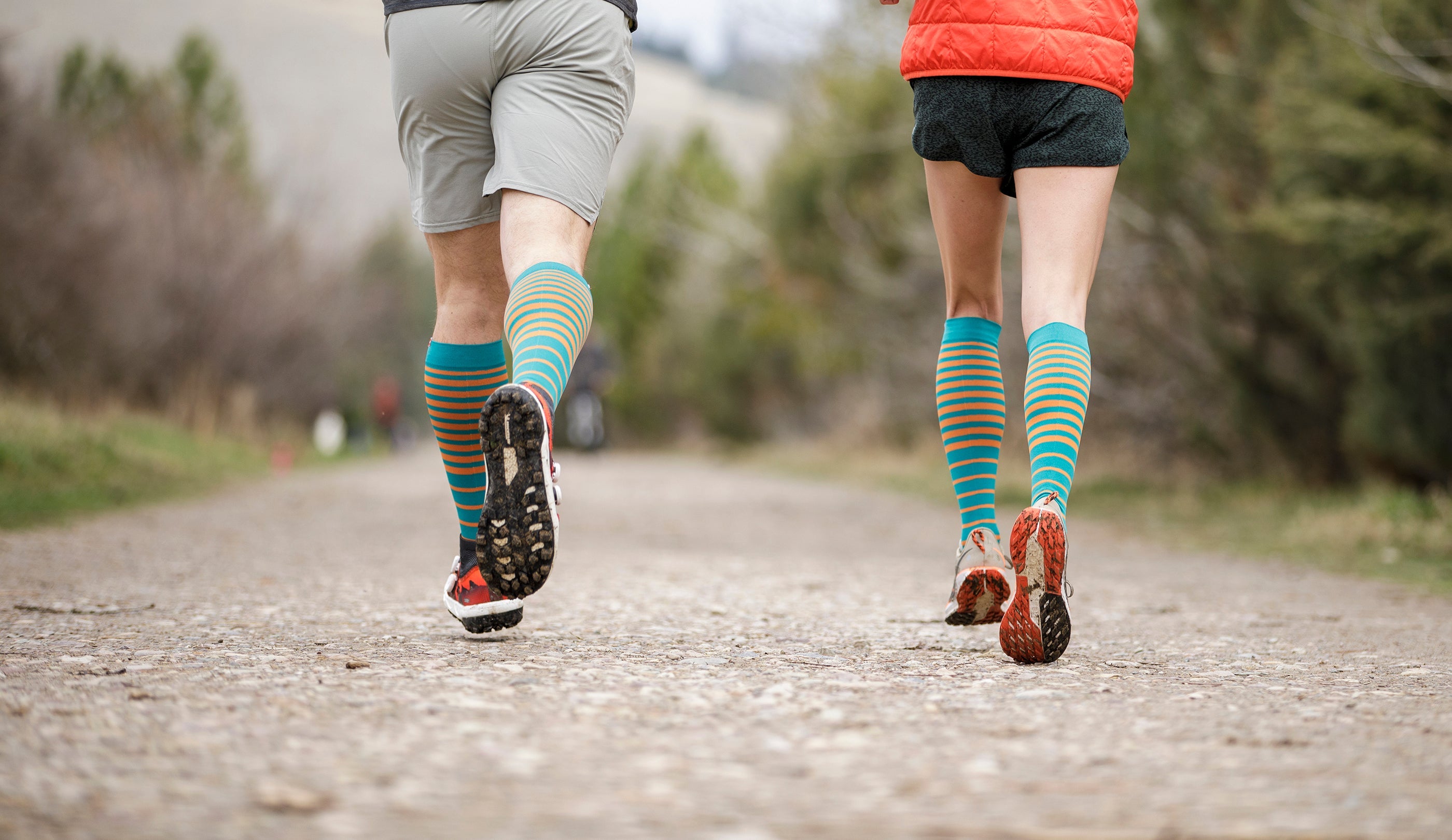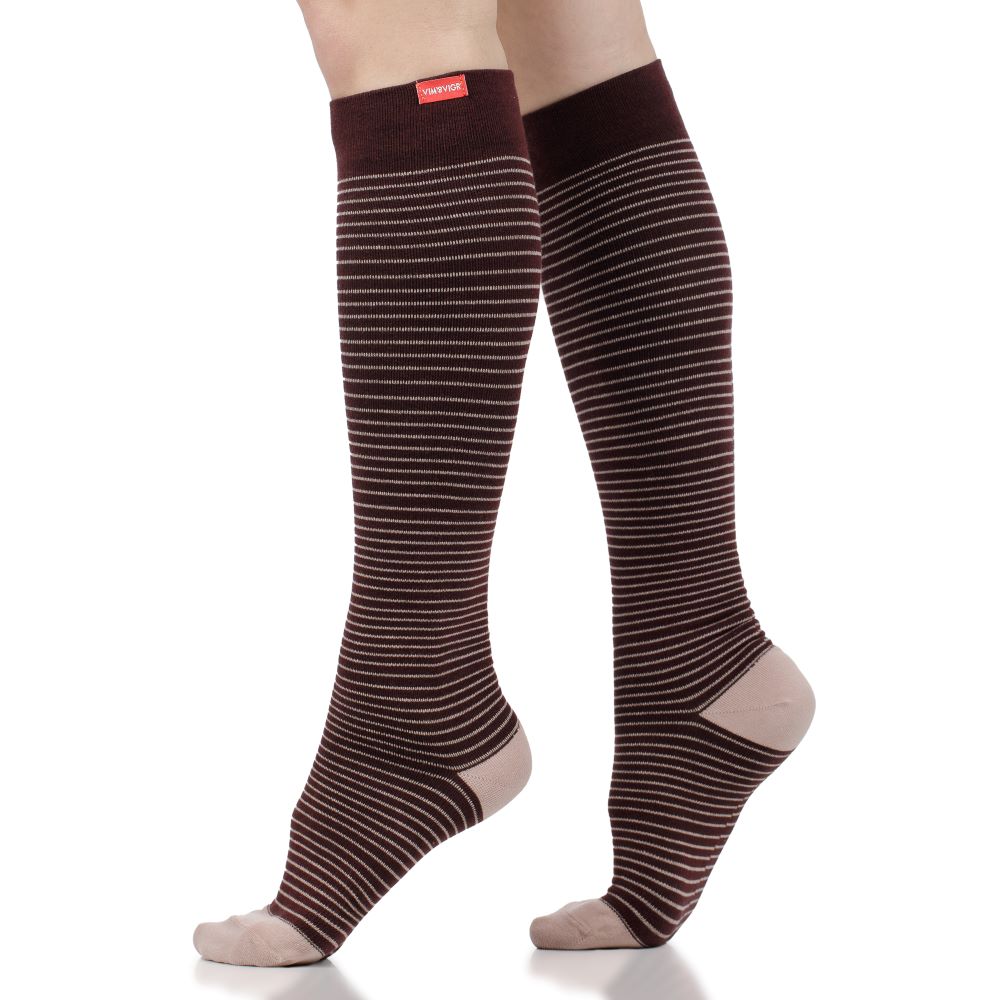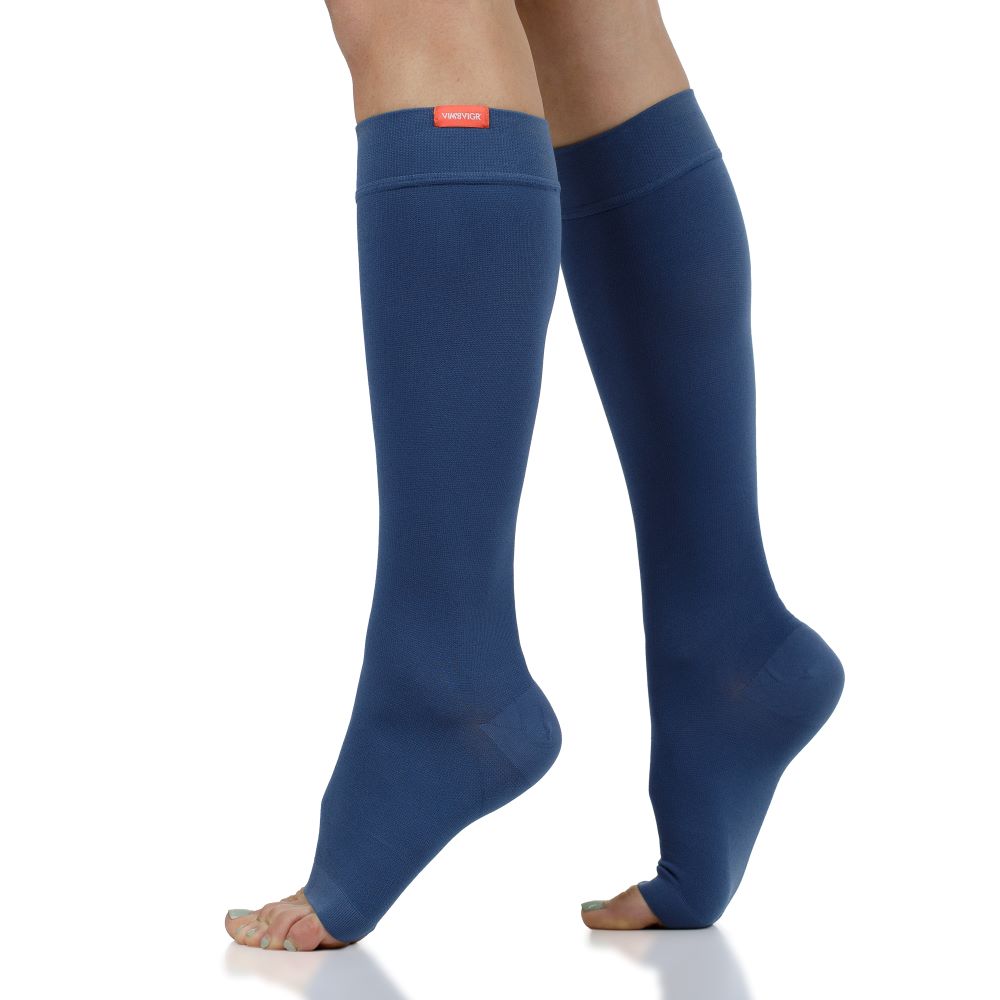Managing Stasis Dermatitis with Compression Stockings
Stasis dermatitis predominantly affects patients over 50 years old in the US, but it can be encountered in younger adults as well. It is caused by poor circulation and the pooling of blood in the lower legs, with the immediate result of skin changes, but with potential for various complications. Since it is linked to poor blood flow, it can also be managed with the help of garments like compression socks.
To combat the negative effects of venous insufficiency, including stasis dermatitis, compression socks and stockings stimulate blood flow in the lower legs and help reduce the risk of blood pooling at the extremities.
Treating or preventing stasis dermatitis is all about improving circulation. In this blog, we’ll look into how stasis dermatitis compression stockings boost blood flow, what symptom management and relief benefits you can expect, and how to wear compression socks when you suffer from this condition.

How Do Stasis Dermatitis Compression Stockings Work?
Stasis dermatitis is caused by venous insufficiency, which is a blood circulation problem in the lower legs. Additional factors that may increase your risk of developing stasis dermatitis include having varicose veins, blood clots, hypertension, deep vein thrombosis, as well as lifestyle-related concerns such as low levels of physical activity or obesity. Compression socks can address circulatory system concerns by boosting blood flow and reducing the risk of many of them appearing in the first place.
Compression stockings and socks are tight garments that apply a gentle pressure to the lower limbs. Graduated socks are tighter at the ankle, then gradually release the pressure towards the knee. This pushes blood upwards towards the heart, reducing the risk of it pooling around the ankles and possibly creating a blood clot. With blood flowing freely throughout the legs and body, risks of swelling, discomfort, irritation, and stasis dermatitis are reduced.
The Benefits of Compression Socks for Stasis Dermatitis
Thanks to their positive impact on blood flow, compression socks are recommended by doctors to avoid circulatory problems that can lead to stasis dermatitis. Moreover, compression garments protect the lower legs, promote healing, reduce swelling, and provide a comfort-boosting massage.

Improved Blood Circulation
The primary benefit of compression socks for stasis dermatitis is the improvement in blood flow. They’ve been shown to reduce the risk of venous insufficiency, blood clots, and varicose veins, among others. Better blood flow also ensures that oxygen and nutrients are delivered to muscles, helping them recover quicker and boosting energy. As a result, feet and legs feel less tired and sore after long days either standing or sitting for extended periods of time.
People with a more sedentary lifestyle, including those working in offices, are increasingly at risk of developing circulatory problems if they don’t move sufficiently throughout the day. Wearing compression socks helps reduce these risks, while also providing relief from cold feet, tingling, and numbness.
Reduced Swelling & Inflammation
Swelling and inflammation are side effects of poor peripheral circulation and blood pooling in the extremities. This can lead to swollen and sore feet and ankles, either from hot weather, prolonged sitting, or long periods of standing.
Compression socks massage the lower limbs, helping to reduce discomfort and boost blood flow upwards from the ankles. The boost in blood flow brings down inflammation and pain. It then combines with a soothing massage to reduce swelling.
Protect the Skin and Promote Skin Healing
Compression socks are not only beneficial for blood circulation, they also help protect the legs from scrapes, bruises, and damage. Wearing compression socks for stasis dermatitis means increased support for the lower limbs, which feel more stable and comfortable when you’re active, too. Additionally, covering the skin up to the knees with a high-quality anti-inflammatory, hypo-allergenic material such as merino wool can be very beneficial for sore skin.
Symptom Relief
While they are great at preventing blood pooling in the lower legs and avoiding venous insufficiency, compression socks also provide relief from stasis dermatitis symptoms. The skin can become irritated and itchy, crack when you scratch it, and even break down and form open sores. You can wear compression socks to protect the skin and reduce underlying inflammation which can then bring down irritation at the skin surface.
Moreover, pain and discomfort caused by swelling from blood pooling will be reduced by compression socks acting to boost circulation.
Prevention and Minimized Recurrence
When it comes to conditions like stasis dermatitis, prevention can be effective, as long as you understand the risks and how to address them. Since stasis dermatitis is caused by venous insufficiency and blood pooling in the lower legs, wearing compression socks to counter this is an easy, comfortable way to do so. Compression stockings also help prevent blood clots, DVT, and other more serious circulatory problems - all by simply wearing a piece of clothing which can earn you style points, too!

How to Use Compression Stockings for Stasis Dermatitis
So, how can you wear compression garments to prevent or treat the symptoms of stasis dermatitis? Whilst there are no particular restrictions around how long you can wear these socks, it’s a good idea to experiment and see what works best for you, starting with wearing them for a short time first.
Once you’re comfortable with the feeling of pressure from compression socks, we recommend wearing them during periods when you know you’ll be sitting or standing for long stretches of time. A good example is a long airplane ride, but many people find that wearing compression stockings or socks for an office job, or as teachers, nurses, or sales reps, is also very efficient.
Additionally, medics often recommend compression socks for patients with reduced mobility or for those who are bed-ridden (for example, when recovering from surgery). You’ll also benefit from wearing them when you’ve had an injury, such as an ankle sprain, and are going back to walking. It’s important to keep active when you have venous insufficiency and stasis dermatitis, so wearing compression socks when you go for a walk is a good way to have some extra support to the joints and muscles, while also continuing to boost blood flow in the lower limbs.
Note: Do not wear compression stockings if you have open sores or ulcers on the lower legs. Consult with your doctor in this case, as it may be more beneficial to let the skin breathe until the sores are healed, then you can add compression socks to your rotation.
Choosing the Best Compression Socks for Stasis Dermatitis
To fully benefit from compression socks, you need to ensure they fit you well, that you’re wearing the most appropriate material for your activity or weather conditions, and that the socks apply the right amount of pressure to your limbs.
Sizing and Fitting Guidelines
If you don’t find your compression socks comfortable, you’re less likely to wear them and therefore get the associated benefits. Moreover, socks that are too tight will negate any benefits since they risk cutting off your circulation, irritating the skin, and causing pain and discomfort. This is why sizing is an essential part of picking the right compression socks for you.

It’s a good idea to follow a sizing guide before you order your first pair of compression socks. Moreover, many people find them difficult to put on correctly, so we’ve put together a clear guide on how to do that here.
Choosing the Appropriate Compression Level
Not all compression socks are the same - they vary in how much pressure is applied to your legs, which is an important factor in how comfortable and effective they will be.
The lightest effective compression socks are 15-20 mmHg. These are great for everyday wear and for first-time wearers, feeling like a gentle pressure is applied to the limbs, without it being too constricting. You can buy these directly, without a prescription, and wear as a preventative measure against developing conditions like stasis dermatitis.
For those already suffering from varicose veins, DVT, or blood clots, firmer compression socks are recommended. At 20-30 mmHg, many doctors will suggest these for when you’re recovering from surgery, too.
Finally, your doctor may prescribe 30-40 mmHg compression socks if you’re suffering from chronic venous insufficiency. These are prescription-only and provide the highest level of support to the lower legs.
Material and Style Options
Choosing the right material is also an important part of finding the best compression socks for stasis dermatitis. Since the skin on your lower legs is very sensitive in this situation, we recommend soft, soothing merino wool as a first choice. Merino wool socks are hypoallergenic, helping prevent infection if you have any sores on your lower legs. They’re also great for regulating temperature and wicking away moisture to keep feet dry and comfortable all day long.
Another good option for stasis dermatitis or its prevention is cotton - a versatile material for everyday wear. Its only downside is that it doesn’t wick away moisture as well as merino wool.
And don’t forget that you can also choose from various designs and styles for your compression socks. Open-toe socks are great for wearing with sandals, while full-length stockings or tights provide better coverage and can be worn under dresses in winter.

Frequently Asked Questions
What is Venous Stasis Dermatitis and Who is at Risk?
Venous stasis dermatitis is a condition in which the skin on the lower legs changes because of poor blood circulation. It can develop into sores and ulcers, or cracking skin which has become very dry.
You may be at risk of stasis dermatitis if you have venous insufficiency, where the blood vessels in your lower legs don’t allow blood to flow back up to the heart. It’s also a condition that people with blood clots, deep vein thrombosis, or edema can develop. More underlying health conditions that increase the risk of stasis dermatitis include hypertension, kidney problems, lack of exercise, obesity, or even pregnancy.
What are the Symptoms of Stasis Dermatitis?
The first sign of stasis dermatitis is swelling in the legs and ankles and potentially a discoloration of the skin. You may also have itchy skin, skin can turn a yellowish brown, or you can develop itchy, red patches. Some patients feel pain in the affected area as well.
Without treatment, stasis dermatitis can cause leg and foot ulcers or an infection called cellulitis.
Is Leg Massage Good for Stasis Dermatitis?
One of the reasons patients develop stasis dermatitis is swelling, which is caused by the build-up of fluid or by blood pooling in the ankles and lower legs. Being active can help reduce this risk, while a light leg massage can help bring down the swelling.
Rather than a full-on massage therapy, you can begin by elevating your feet and giving yourself a light self-massage. Additionally, the gentle massage applied by compression socks contributes to relaxing the muscles, boosting circulation, and reducing inflammation and swelling.
Find your new favorite pair of compression socks here today!



















Leave a comment